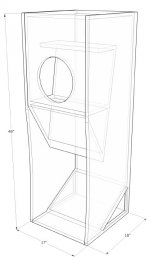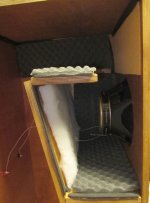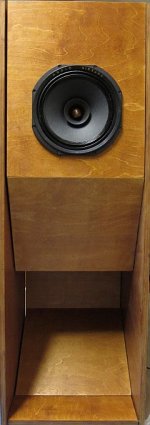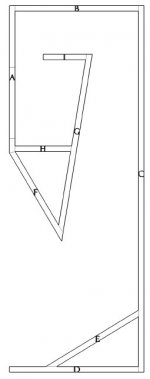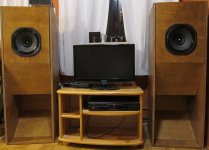1808 vs 1772
So, Dave... you actually got to hear the both side by side ? Like I said before, i heard a pair of the 1772's at my buddy Mark's house, and while I thought they were very good, i ordered a pair of the 1808's. Two reasons:
1) We have THEE greatest audiphile group here in town, and wanted all the members to be able to hear both versions, and...
2) Someday I wish to front horn load them, open backed, and with the higher Qts and tilted up highs, i thought it would be a better fit.
Looking fwd to hearing your comparison descriptions . Thanks.
I preferred the 1808 over the 1772.
dave
So, Dave... you actually got to hear the both side by side ? Like I said before, i heard a pair of the 1772's at my buddy Mark's house, and while I thought they were very good, i ordered a pair of the 1808's. Two reasons:
1) We have THEE greatest audiphile group here in town, and wanted all the members to be able to hear both versions, and...
2) Someday I wish to front horn load them, open backed, and with the higher Qts and tilted up highs, i thought it would be a better fit.
Looking fwd to hearing your comparison descriptions . Thanks.
Sort of side by side... one after the other in my office system (a week or so each) after i'd finished treatment, Then followed by a pair of FE206eSReN which were a step up from either of them.
dave
dave
AN10 in EZ10 back-loaded horns
I am in the process of building and tuning back-loaded horns for AN10 cast frame drivers. I have used the EZ10 plans and I have reached a point to be able to test the sound with one of the side walls attached just with a clamp (to allow me to open the speaker and play with acoustic foam without even fixing it firmly just yet etc.).
I must say I did like what I heard so far but... after around 10 hours of playing, I am afraid I miss "transparent clarity" of sound.
Do you think I should just let the drivers burn-in first or do you think it makes sense to play with the foam in the compression chamber now? This is my very first back-loaded horn project and only second DIY speaker project so any suggestions or shared experience is welcome. Thanks.
Peter
I am in the process of building and tuning back-loaded horns for AN10 cast frame drivers. I have used the EZ10 plans and I have reached a point to be able to test the sound with one of the side walls attached just with a clamp (to allow me to open the speaker and play with acoustic foam without even fixing it firmly just yet etc.).
I must say I did like what I heard so far but... after around 10 hours of playing, I am afraid I miss "transparent clarity" of sound.
Do you think I should just let the drivers burn-in first or do you think it makes sense to play with the foam in the compression chamber now? This is my very first back-loaded horn project and only second DIY speaker project so any suggestions or shared experience is welcome. Thanks.
Peter
Attachments
I have no experience with this driver, so don't have a clue whether or not it will even 'open up' over time or just get a little less 'shouty'/forward'. In just looking at how you have damped the horn so far though..............
I have not had good luck with foams in general for cab damping and not sure what the white stuff is (felt carpet underlay and acoustic fiberglass are my preferences), but with a slanted back board I would leave it and one side of the chamber undamped (at least initially) and instead damp the underside and edge of the upper plate as well as the inside of the top of the horn to ensure the eigenmodes between it, the horn's throat and the chamber bottom are well damped. Such layouts can be problematic, so sometimes require some damping material stretched across it to get the smoothest horn action. Initial horn damping would consist of damping one of each parallel surfaces out to the back of the cab, i.e. top, back and one side.
GM
I have not had good luck with foams in general for cab damping and not sure what the white stuff is (felt carpet underlay and acoustic fiberglass are my preferences), but with a slanted back board I would leave it and one side of the chamber undamped (at least initially) and instead damp the underside and edge of the upper plate as well as the inside of the top of the horn to ensure the eigenmodes between it, the horn's throat and the chamber bottom are well damped. Such layouts can be problematic, so sometimes require some damping material stretched across it to get the smoothest horn action. Initial horn damping would consist of damping one of each parallel surfaces out to the back of the cab, i.e. top, back and one side.
GM
I am in the process of building and tuning back-loaded horns for AN10 cast frame drivers. I have used the EZ10 plans and I have reached a point to be able to test the sound with one of the side walls attached just with a clamp (to allow me to open the speaker and play with acoustic foam without even fixing it firmly just yet etc.).
I must say I did like what I heard so far but... after around 10 hours of playing, I am afraid I miss "transparent clarity" of sound.
Hi!
I'd put 45 degree reflectors in that horn design at the 90 degree bends - those 90 degree surfaces are going to be bouncing the sound around like crazy. You might usefully add a short 9 inch to 18 inch or so horn at the front to balance lower midrange and focus the higher frequencies. But perhaps this driver might be best in open baffle. The 8 inch unit might give more transparency but otherwise you could add a cheap peizo tweeter - or two at 45 degrees to simply add sheen to the top end of the sound.
Best wishes
David P
Audio Nirvana 10" pressed frame
Hi,
I own the above and build a few different cabinets, but best result was the recommended vented box provided with the drivers with 2.5 cubic foot capacity,using 20mm thick bamboo ply as no other material, like MDF rubbish or marine ply could make the grade.
It is like, have you ever seen an acoustic guitar made from MDF, no no no.
The bamboo ply has a musical tone and ambiance to it. I dampened them to suit
and use an Audio Pro B2.7 sub woofer with them, with RCA input from preamp and not speaker cables from the power amps as that sounds grouse.
I belong to an Audio club with members with very expensive hi end gear and I have not found any system that can beat them for detail, separation, sound stage, tone, transparency, etc. and off cause I ran all valve gear.
Cheers vir eers.
Hi,
I own the above and build a few different cabinets, but best result was the recommended vented box provided with the drivers with 2.5 cubic foot capacity,using 20mm thick bamboo ply as no other material, like MDF rubbish or marine ply could make the grade.
It is like, have you ever seen an acoustic guitar made from MDF, no no no.
The bamboo ply has a musical tone and ambiance to it. I dampened them to suit
and use an Audio Pro B2.7 sub woofer with them, with RCA input from preamp and not speaker cables from the power amps as that sounds grouse.
I belong to an Audio club with members with very expensive hi end gear and I have not found any system that can beat them for detail, separation, sound stage, tone, transparency, etc. and off cause I ran all valve gear.
Cheers vir eers.
Actually, there have been a handful of hand-made acoustic guitars in MDF. Just to prove they can I suppose. Allegedly they were reasonable, but more work to create a decent one. More to the point though, a loudspeaker is not an instrument. It is designed to reproduce the musical tones of voices and instruments that have already been recorded, not colour them by adding tones of its own devising.
Adding reflectors will probably just cause more problems; the LF wavelengths are too long to be bothered, & you may end up with more unwanted midrange (which with their shorter wavelength are more affected by sharp turns) passing through. That's why many of my designs use the folding as a functional part of the design; in conjuction with the low-pass chamber they set the upper corner frequency of the horn.
Adding reflectors will probably just cause more problems; the LF wavelengths are too long to be bothered, & you may end up with more unwanted midrange (which with their shorter wavelength are more affected by sharp turns) passing through. That's why many of my designs use the folding as a functional part of the design; in conjuction with the low-pass chamber they set the upper corner frequency of the horn.
Last edited:
Actually, there have been a handful of hand-made acoustic guitars in MDF. Just to prove they can I suppose. Allegedly they were reasonable, but more work to create a decent one. More to the point though, a loudspeaker is not an instrument. It is designed to reproduce the musical tones of voices and instruments that have already been recorded, not colour them by adding tones of its own devising.
Adding reflectors will probably just cause more problems; the LF wavelengths are too long to be bothered, & you may end up with more unwanted midrange (which with their shorter wavelength are more affected by sharp turns) passing through. That's why many of my designs use the folding as a functional part of the design; in conjuction with the low-pass chamber they set the upper corner frequency of the horn.
Well said Scottmoose!
Thank you everyone for your responses. If I consider the fact that I already chose a 10" and not 8" driver and a BLH cabinet and not open baffle or vented box, I am left with the option of making (at least somewhat) educated experiments with damping and testing. It would certainly help to have a better understanding of the principles of BLH - what would you suggest for a BLH beginner to read?
My questions at this point would be:
a) if the manufacturer-given frequency response specs (http://www.commonsenseaudio.com/an10cfspecs.jpg) show the driver is capable of delivering clean treble, what might cause that it doesn't (I guess apart from the possibility that the theoretical specs are off)?
b) how important in back-loaded horns is the width of the path (sorry for my lack of terminology) such as distance from 'I' piece to 'A', 'I' to 'B', and 'I' to 'C'? I understand the author of the design Thomas Petzwinkler used software to calculate the dimensions. Would adding 45 degree reflectors in the 'H+A' corner or 'A+B' corner or 'B+C' corner mess up the simulated frequency response (http://spqracoustics.files.wordpress.com/2008/02/ez10-in-room.gif)?
Finally, after some 8 more hours of playing, the character of AN10 is still changing (I guess that should be expected), so maybe the best thing is to wait...?
Peter
My questions at this point would be:
a) if the manufacturer-given frequency response specs (http://www.commonsenseaudio.com/an10cfspecs.jpg) show the driver is capable of delivering clean treble, what might cause that it doesn't (I guess apart from the possibility that the theoretical specs are off)?
b) how important in back-loaded horns is the width of the path (sorry for my lack of terminology) such as distance from 'I' piece to 'A', 'I' to 'B', and 'I' to 'C'? I understand the author of the design Thomas Petzwinkler used software to calculate the dimensions. Would adding 45 degree reflectors in the 'H+A' corner or 'A+B' corner or 'B+C' corner mess up the simulated frequency response (http://spqracoustics.files.wordpress.com/2008/02/ez10-in-room.gif)?
Finally, after some 8 more hours of playing, the character of AN10 is still changing (I guess that should be expected), so maybe the best thing is to wait...?
Peter
Last edited:
Peter,
I have these drivers and the AN8 cast frame as well. Both sound bright and somewhat harsh at first. Give them 100-200 hours and they will sound much better although they will always lean towards a brighter sound. You will get the transparent sound you are after but it will take a little more time.
LAL
I have these drivers and the AN8 cast frame as well. Both sound bright and somewhat harsh at first. Give them 100-200 hours and they will sound much better although they will always lean towards a brighter sound. You will get the transparent sound you are after but it will take a little more time.
LAL
Chances are they will need more break in (i.e. breaking) before they're sounding as hoped. Re the others -
a/ Chances are they're being economical with the actualite. Most driver manufacturers tend to present an idealised version of the truth.
b/ Length is generally taken along the centreline of the horn. Deflectors (assuming they're done properly) are good for maximising efficiency over the broadest possible BW, but generally, you don't actually want a particularly high acoustic XO from the horn to direct radiation or you'll run into severe group-delay / phasing problems up through the lower midrange.
a/ Chances are they're being economical with the actualite. Most driver manufacturers tend to present an idealised version of the truth.
b/ Length is generally taken along the centreline of the horn. Deflectors (assuming they're done properly) are good for maximising efficiency over the broadest possible BW, but generally, you don't actually want a particularly high acoustic XO from the horn to direct radiation or you'll run into severe group-delay / phasing problems up through the lower midrange.
I like the idea of fullranges, but the fact that (also with Lowthers) you have to wait around 100-200 hours of "burn in" is in my opinion showing that the system is not stable and its parameters are changing (developing) in time. So, my question is, is the process of "burning in" continuing and is the speaker slowly changing its character each hour of playing or do you believe that it somehow stops after it reaches its optimal level ?
Hey Peter,
Are you sure you have the cabinet properly sealed? I can see slivers of light creeping through on the closed end.
I have no experience with back loaded horns, but they look like the best choice for a driver like AN. The response of the AN is tilted up in the high frequencies and you need a BLH to improve its efficiency in the bottom and balance it out.
What amplifier are you using? If you are using a big SS amp with a high damping factor, it is going to make the AN sound even more shrill. Use a tube amp (or even an good SS amp) with a low damping factor. Makes a big difference in the bass.
Are you sure you have the cabinet properly sealed? I can see slivers of light creeping through on the closed end.
I have no experience with back loaded horns, but they look like the best choice for a driver like AN. The response of the AN is tilted up in the high frequencies and you need a BLH to improve its efficiency in the bottom and balance it out.
What amplifier are you using? If you are using a big SS amp with a high damping factor, it is going to make the AN sound even more shrill. Use a tube amp (or even an good SS amp) with a low damping factor. Makes a big difference in the bass.
Hi Adam, I only had one pair of fullrange speaker before - Fostex FE127eN in Metronome enclosure and all I can say their sound stabilised (in a good way) after some time. Then again in DIY hobby, there are always some changes in the system - tweaking the speakers, changing cables, modifying parts in the amp (if not replacing the amp), aging tubes, changing sources etc. etc. So I came to accept that the sound "develops" in time anyway (maybe less relevant, but the same applies for live performances of musicians).
As for the Metronomes with Fostex FE127eN (http://www.diyaudio.com/forums/full...ge-speaker-photo-gallery-138.html#post2429908), they are incredibly detailed and musical and - yes - they do show differences in sound based on changes of components up the audio chain. I guess the only reason I am building an alternative is the DIY bug to try out new things and curiousity about back loaded horns with high efficiency speakers paired with a SET amp...
As for the Metronomes with Fostex FE127eN (http://www.diyaudio.com/forums/full...ge-speaker-photo-gallery-138.html#post2429908), they are incredibly detailed and musical and - yes - they do show differences in sound based on changes of components up the audio chain. I guess the only reason I am building an alternative is the DIY bug to try out new things and curiousity about back loaded horns with high efficiency speakers paired with a SET amp...
Hi ra7,
the cabinet has not been fully finalized yet (and there is indeed a very narrow glue-filled transparent gap that you noticed in the bottom half of the cabinet).
The cabinets are still in the garage where I worked on them with my father and I have not tested them with my main amplifier (SET EL84 tube amp). For testing, I first used an SS amp and then a push-pull EL84 tube amp and the latter was indeed better.
the cabinet has not been fully finalized yet (and there is indeed a very narrow glue-filled transparent gap that you noticed in the bottom half of the cabinet).
The cabinets are still in the garage where I worked on them with my father and I have not tested them with my main amplifier (SET EL84 tube amp). For testing, I first used an SS amp and then a push-pull EL84 tube amp and the latter was indeed better.
Hi Scott,
thanks for your answers. Where in the frequency spectrum is usually the acoustic XO from the horn to direct radiation?
thanks for your answers. Where in the frequency spectrum is usually the acoustic XO from the horn to direct radiation?
Depends on the design. 😉
Ideally, as you can't run any back loaded design up particularly high, you want a driver with a reasonably low mass corner so your horn assists below that & you obtain a seamless transition to direct radiation. 250Hz - 300Hz is about the limit you can run a back horn up to without suffering from the aforementioned adverse group delay, phasing etc.
Ideally, as you can't run any back loaded design up particularly high, you want a driver with a reasonably low mass corner so your horn assists below that & you obtain a seamless transition to direct radiation. 250Hz - 300Hz is about the limit you can run a back horn up to without suffering from the aforementioned adverse group delay, phasing etc.
Mass corner? Nothing per se to do with horns, it's the point at which the driver's response is 3dB down on the bottom end (generally taken as 2*Fs/Qt).
Listening impressions: AN10 in EZ10 back-loaded horns
In case this is of interest and relevant to this topic, I summarize below my listening impressions of the AN10 in back-loaded horns EZ10.
All the observations below are my subjective opinions, with no scientific measurements involved.
Because of my limited experience with speaker building, I am often unable to differentiate between effects of a speaker cabinet, damping, speaker placement/room acoustics, and driver itself.
The speakers have been playing for some 100 hours, so the drivers should be - for the most part - burned-in already.
I kept the source, amplifier, and speaker cables the same when replacing my previous speakers (Metronomes with "EnABL-ed" fullrange drivers Fostex FE127eN) to be able to better spot any differences. Naturally, the Metronomes were my reference point for this comparison so any evaluation remarks on EZ10 with AN10 are to be understood in that light.
________
Presence:
Because of the EnABL treatment of Fostex FE127eN, the amount of micro-level musical information through the Mets is hard to beat. The noise floor was higher with EZ10/AN10 and overall there was a feeling the presence was "recessed" - less of "being here" atmosphere. Personal preferences might vary, of course.
_____________________
Disappearing of speakers:
With only some basic adjustments in speaker placement and room acoustics, the EZ10/AN10 manage to disappear with some music but not yet to such a degree as the Mets. Perhaps more burn-in is required or changes in damping or greater distance between the speakers. This needs more experimentation as I feel there is still potential for improvement.
______
Bass:
EZ10/AN10 are without doubt the winner here. The bass is full and much more present than with the Mets. I have never heard better bass in my system before. The planned EnABL treatment of drivers might make the bass notes more cleanly defined as they are now, perhaps.
________
Vocals:
I would say with good recordings the enjoyment of vocals is comparable/equal between EZ10/AN10 and the Mets. With less quality recordings, the vocals are less upfront with EZ10/AN10 and more "in the back" and somewhat veiled. I wonder if this can be changed with damping and/or bracing.
______
Treble:
With the micro-level detail and lower noise floor of the Mets, the cymbals sound more natural with the Mets. Still, the highs are enjoayble on EZ10/AN10 but maybe sound a bit less natural.
_____________________
Separation of instruments:
For everything except bass, the instruments are better defined and separated and placed on the stage with the Mets. Again, some more burn-in of the AN10 drivers may change this and definitely the planned EnABL treatment.
__________
Dynamics:
EZ10/AN10 are much better subjectively in dynamics. They convey both loud and soft passages equally well without a hint of any struggle. Lowering the noise floor will hopefully help even further with the quieter passages.
__________
My conclusion:
EZ10/AN10 show great potential. They do very well in dynamics and bass and I hope they can be improved in other areas. Further tuning will involve:
- speaker placement/room acoustics changes,
- damping changes (at this point, no two parallel inside walls are left undamped in the top part of the cabinets - but changes can definitely improve things, I believe),
- EnABL treatment to lower the noise floor and clear micro-level detail,
- bracing - I wonder if putting some bracing between the back of the driver and the back panel of the compression chamber might help.
Again, please take these observations for what they are worth to you considering this was my first BLH project and I cannot consider myself experienced in speaker building.
Best,
Peter
In case this is of interest and relevant to this topic, I summarize below my listening impressions of the AN10 in back-loaded horns EZ10.
All the observations below are my subjective opinions, with no scientific measurements involved.
Because of my limited experience with speaker building, I am often unable to differentiate between effects of a speaker cabinet, damping, speaker placement/room acoustics, and driver itself.
The speakers have been playing for some 100 hours, so the drivers should be - for the most part - burned-in already.
I kept the source, amplifier, and speaker cables the same when replacing my previous speakers (Metronomes with "EnABL-ed" fullrange drivers Fostex FE127eN) to be able to better spot any differences. Naturally, the Metronomes were my reference point for this comparison so any evaluation remarks on EZ10 with AN10 are to be understood in that light.
________
Presence:
Because of the EnABL treatment of Fostex FE127eN, the amount of micro-level musical information through the Mets is hard to beat. The noise floor was higher with EZ10/AN10 and overall there was a feeling the presence was "recessed" - less of "being here" atmosphere. Personal preferences might vary, of course.
_____________________
Disappearing of speakers:
With only some basic adjustments in speaker placement and room acoustics, the EZ10/AN10 manage to disappear with some music but not yet to such a degree as the Mets. Perhaps more burn-in is required or changes in damping or greater distance between the speakers. This needs more experimentation as I feel there is still potential for improvement.
______
Bass:
EZ10/AN10 are without doubt the winner here. The bass is full and much more present than with the Mets. I have never heard better bass in my system before. The planned EnABL treatment of drivers might make the bass notes more cleanly defined as they are now, perhaps.
________
Vocals:
I would say with good recordings the enjoyment of vocals is comparable/equal between EZ10/AN10 and the Mets. With less quality recordings, the vocals are less upfront with EZ10/AN10 and more "in the back" and somewhat veiled. I wonder if this can be changed with damping and/or bracing.
______
Treble:
With the micro-level detail and lower noise floor of the Mets, the cymbals sound more natural with the Mets. Still, the highs are enjoayble on EZ10/AN10 but maybe sound a bit less natural.
_____________________
Separation of instruments:
For everything except bass, the instruments are better defined and separated and placed on the stage with the Mets. Again, some more burn-in of the AN10 drivers may change this and definitely the planned EnABL treatment.
__________
Dynamics:
EZ10/AN10 are much better subjectively in dynamics. They convey both loud and soft passages equally well without a hint of any struggle. Lowering the noise floor will hopefully help even further with the quieter passages.
__________
My conclusion:
EZ10/AN10 show great potential. They do very well in dynamics and bass and I hope they can be improved in other areas. Further tuning will involve:
- speaker placement/room acoustics changes,
- damping changes (at this point, no two parallel inside walls are left undamped in the top part of the cabinets - but changes can definitely improve things, I believe),
- EnABL treatment to lower the noise floor and clear micro-level detail,
- bracing - I wonder if putting some bracing between the back of the driver and the back panel of the compression chamber might help.
Again, please take these observations for what they are worth to you considering this was my first BLH project and I cannot consider myself experienced in speaker building.
Best,
Peter
Attachments
- Status
- Not open for further replies.
- Home
- Loudspeakers
- Full Range
- Audio Nirvana Super Cast 10" (New)
